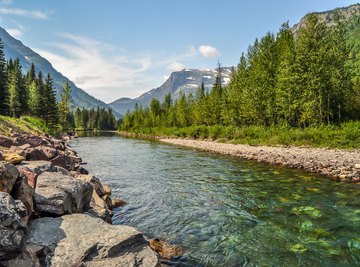
An aquatic ecosystem is a water-based environment. Plants and animals interact with the biotic and abiotic factors of aquatic ecosystems. Aquatic ecosystems are categorized as the marine ecosystem and the freshwater ecosystem. A stream is an example of a freshwater ecosystem.
Abiotic factors are the nonliving components that form the environment in which the organisms subsist in a stream (freshwater ecosystem). These include factors such as light, current, temperature, substrate and chemical composition.
Types of Ecosystems
Ecosystems can be aquatic, terrestrial, or a combination of the two. Oceans, rivers, lakes, and even ponds are all aquatic types of ecosystems. Abiotic factors in the marine biome differ with the location in terms of chemistry, light, currents, and temperature. Organisms adapt to their surrounding abiotic environment resulting in different species assemblages and creating different types of ecosystem interactions.
For example, the cold temperature of the Antarctic results in higher dissolved oxygen concentrations compared with warmer tropical waters. Despite these both being marine environments, they function as very different ecologies due to various abiotic factors in the oceans. The speed at which water moves through will also create different ecosystems due to different species assemblages and interactions. Think about how different organisms would need to adapt to cope with a fast-moving stream compared with a tranquil lake.
Light
Light is an essential factor for photosynthesis. It may also be a habitat factor. Fishes and invertebrates shun sunny spots within the stream in order to be less visible to predators. Most of the life forms are found in places where higher density of light is present. In areas of lower light density, very few species such as amphipods and springtails are found.
Current
Current is a factor that interacts with many abiotic and biotic effects. Many organisms occupy a certain range of water velocities while they get stressed at water with higher velocities. Current performs an essential function of transferring food to waiting organisms. It also transfers oxygen to organisms, which aids with their respiration. The same flow carries nutrients and carbon dioxide to plants.
Temperature
The metabolic rate of almost all the organisms thriving in this ecosystem is influenced by the water temperature. Some organisms such as the trout grow at relatively cool stream temperatures. Other organisms such as the smallmouth bass perform optimally at higher temperatures.
Most streams have temperatures ranging between 32 and 77 degrees Fahrenheit. Subtropical and tropical streams often reach 86 degrees F and some desert streams reach 104 degrees F. The upper range of temperature at which an organism can survive depends on their temperature adaptation pattern over time. Cold-water fishes cannot survive in temperatures above 77 degrees F for a long period of time. A majority of warm-water fishes can withstand temperatures nearing 86 degrees F.
Chemistry
The chemistry of a stream is determined by the geology of its catchment (structure in which the water is collected). Rain and human activity also affect the chemistry of a stream. Streams vary in terms of dissolved oxygen, alkalinity, nutrients and human contaminants.
Oxygen, which is essential for the existence of most organisms, readily dissolves in water. Small, turbulent streams are saturated with oxygen, whereas large, smoothly flowing rivers that have higher metabolic activity may experience oxygen depletion near the bottom. Alkalinity is a measure of the amounts and kinds of compounds that alter the pH of water.
Blackwater streams are acidic in nature, streams draining into fertile soils are slightly alkaline and chalk streams can be extremely alkaline in nature. Nutrients are the elements that support the plants and microbes in sustenance. Human activities contribute greatly to the nutrient load of streams. An example is the large quantities of nitrogen present in water as a result of burning fossil fuels or the manufacture of fertilizers.
References
About the Author
Debashree Sen is a technical writer and has written for non-profit organizations. She has been regularly contributing to eHow since 2009. She is a member of the Society for Technical Communication (STC). She has a master's degrees in professional writing and English literature.
